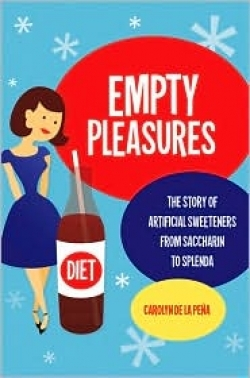Empty Pleasures
The Story of Artificial Sweeteners from Saccharin to Splenda
Available on the table of nearly every restaurant, those little blue, pink, and yellow packets are far more than powder for sweetening coffee—according to author Carolyn de la Peña, they represent a snapshot of American culture and history.
“The story of artificial sweetener reminds us that real people created the industrial food products many are quick to criticize in American life today,” she writes. “We need to take seriously the motivations of these people and begin to see our food products not as ‘artificial’ or ‘industrial’ constructions that assault us. Rather, our food products embody us.”
A professor of American studies at the University of California, Davis, de la Peña also penned the compelling The Body Electric: How Strange Machines Built the Modern American. In that work, she explored the quirky Victorian-to-postwar inventions geared toward health cures, exploring the culture of technology through electric belts and mechanized weights.
That research informs Empty Pleasures to a large degree, since she not only examines health in a subsequent time period—focusing on the 1950s to the 1980s—but also documents an evolution in the American psyche.
That postwar consumer era, she notes, was rife with patriotism displayed via consumption and “better living through chemistry.” The food industry’s major push to make eating fun combined with other cultural drivers (such as the vilification of sugar) to make artificial sweeteners a welcome part of the marketplace.
Starting with the introduction of saccharin at the 1893 World’s Fair, de la Peña documents the history of sweeteners, weaving consumer viewpoints into the account.
When writing the history of a commodity, she notes, it’s easy to focus on consumer manipulation through advertising and marketing. How Americans assign meaning to products and health, however, leads to important insights about the country’s consumerism, food production, eating habits, and health education processes as well. Stories about the people behind the products, and those who rallied against the sweeteners, create a richer view of those colored packets.
Charmingly written and exhaustively researched, de la Peña’s exploration provides a fascinating look into a seemingly commonplace food additive. Most importantly, her insight ultimately provides a call to action. In a century in which our key challenge as Americans is to find a way to limit our desires to what our markets, our planets, and our bodies can hold, “it may be time to reassess what artificial sweeteners and the low-calorie industry they have enabled have actually done.”
Reviewed by
Elizabeth Millard
Disclosure: This article is not an endorsement, but a review. The publisher of this book provided free copies of the book to have their book reviewed by a professional reviewer. No fee was paid by the publisher for this review. Foreword Reviews only recommends books that we love. Foreword Magazine, Inc. is disclosing this in accordance with the Federal Trade Commission’s 16 CFR, Part 255.

